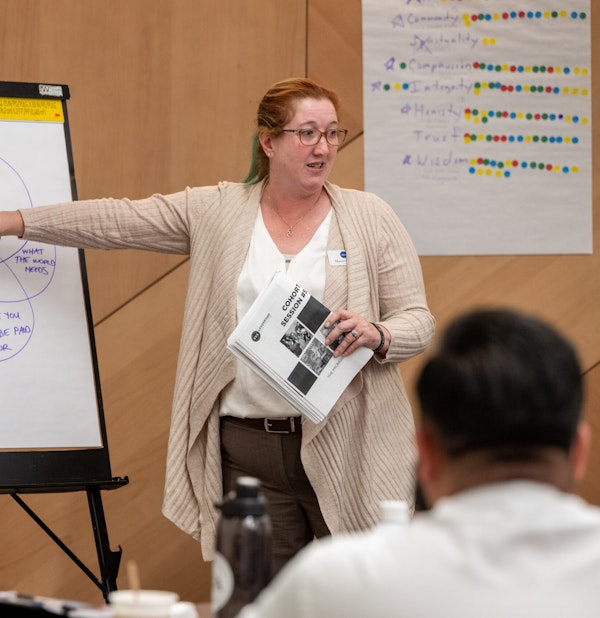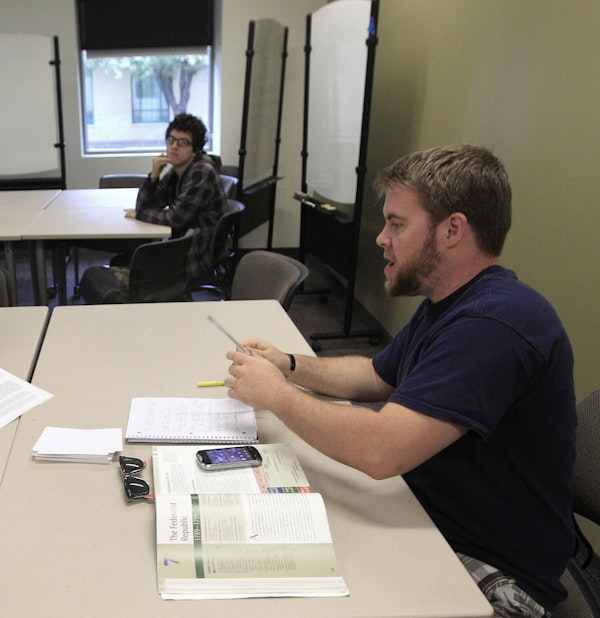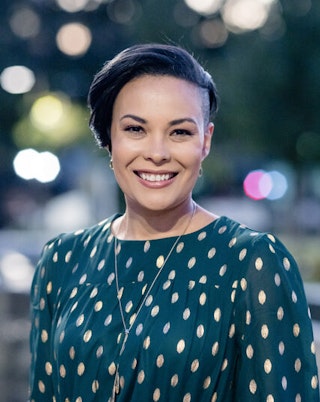Interview
From service into students
LeNaya Hezel details the difficulties involved in making the transition from the military to higher education – and explains how to help our veterans succeed
 A professor watches a student dressed in U.S. army uniform writing an equation on a whiteboard. (Getty Images/Ariel Skelley)
A professor watches a student dressed in U.S. army uniform writing an equation on a whiteboard. (Getty Images/Ariel Skelley)
In 2023, more than 862,000 U.S. veterans used their Post-9/11 GI Bill benefits to get a postsecondary education. The benefits of such instruction are obvious. Yet veterans and active-duty service members can face special challenges when making the transition from the military to school, and the government programs that exist to support them can be confusing and hard to access. To better understand the situation and how to fix it, The Catalyst’s Jonathan Tepperman spoke to LeNaya Hezel, Chief Programs Officer at the Warrior-Scholar Project and the former Co-Chair of the Veteran and Military Families Education Policy Working Group at the Bush Institute. Their conversation has been edited for length and clarity. For more detail on this topic, you can find the Bush Institute’s policy brief here.
Continuing to build skills and knowledge after high school is essential for most Americans to access good jobs. One such pathway is through higher education. Do enough U.S. veterans currently manage to get that education?
What we’re seeing today among service members and veterans is that they’re enrolling in higher education, but they’re not all completing degree programs, especially online programs. If you’re still serving on active duty, that means that you’re working, and that can make finishing your degree very difficult.
As for veterans, that requires more scrutiny. They are enrolling in higher education, but where are they enrolling? Is it predominantly online institutions? Are they looking at community colleges? Are they pursuing graduate degrees? A lot more work needs to be done to understand this issue.
Making the transition from the military to academic life can be hard. Discuss some of the challenges.
When you join the military, you learn social cultures, chain of command, what to wear, your MOS [military occupational specialty]. Those are among the many things the military instills in you. Then you get to a higher education setting, and it’s laissez-faire. And there is no one telling you, with a checklist, “These are the things that you need to do to be successful.” All of a sudden, the question is more, “What is it that I would like to do?” than “What do I need to do for my unit or for the command?” That can be a little overwhelming. Figuring out your postservice identity can also be challenging.
How did you first become aware of the special challenges that veterans and service members can face when making the transition to academic life?
It was when I became a military spouse and watched my partner go through a similar transition. And my spouse is an officer. Officers typically get a lot more support and access to resources and networks. Many of them have already gone through college.
But the enlisted population may not necessarily have those same experiences and social circles. And that’s where communities and organizations that support this population, like the Warrior-Scholar Project, really play a pivotal role.
 A woman points to an easel board in front of veteran students on October 19, 2024. (Student Veterans of America Leadership Institute)
A woman points to an easel board in front of veteran students on October 19, 2024. (Student Veterans of America Leadership Institute)
Describe the two main U.S. government programs that are designed to help service members and veterans and their families make the transition from military life to academia. Then describe the gaps or problems with those programs.
I learned about these programs when I was working on my dissertation, which involved looking at how universities structure their services for military-connected students. One of the two main programs is called VetSuccess on Campus, or VSOC. It’s a program that the Department of Veterans Affairs implemented in 2009, under which college campuses receive a vocational rehabilitation counselor. (This falls under the umbrella of a larger program called Veteran Readiness and Employment, or VR&E.) What that counselor aims to do is serve as a VA representative on campus to help veterans prepare to make the transition into a career.
But what I found is that these counselors don’t actually do career advising at all. Instead, they spend most of their time answering veterans’ questions about how to process their VR&E benefits, because there have been significant delays in getting those benefits, and the process of getting them is very different from those used for benefits under the post-9/11 GI bill.
Then, through my work at Warrior Scholar Project, I learned about a program called VITAL, which stands for Veterans Integration to Academic Leadership. VITAL is housed within the Veterans Health Administration within the VA. Universities across the country can apply to have a VITAL program on campus, and those programs provide counselors to help service members and veterans navigate the transition into higher education. These counselors serve as kind of a coordinated social worker to connect service members and veterans to care within the VA or resources available on campus.
But part of the problem is that VITAL is not well known. You have this complicated situation in which people know about VSOC, which says that it’s supposed to provide transition services but really only focuses on helping veterans utilize their VR&E benefits. And then you have another program, VITAL, which very few people know about – I’d been in this game for years and only learned about in 2023 – and which does exactly what VSOC is supposed to do.
Are there other gaps or shortcomings? Are the programs limited in the number of schools that they cover?
The last time I looked at the data for this, 25 states did not have a VITAL program. I live in the Washington, D.C., area, and we have a high population of veterans here, but there is no VITAL program nearby.
It seems like there are a couple of different problems that need to be addressed: expanding the geographic scope of these programs and increasing public awareness of them.
In 2022, the Strong Veterans Act was passed, which calls for a congressional evaluation of VITAL. But it’s now 2025 and that report has not been published. So we need a better understanding of how well the VITAL program is functioning. And we need a similar evaluation of the VSOC program and a comparative analysis of the two that identifies any overlaps or redundancies as well as opportunities for improvement.
Part of the reason that is so important is because even within the Department of Veterans Affairs, some folks don’t know about the VITAL program. So they may not realize that there’s a duplicative program within house.
Next, we need more public awareness for universities and administrators, so that they can start asking questions like, “How do we get a VITAL program on our campus?” And then what’s even more important is to raise awareness among service members and veterans, so that when they consider what schools to go to, they know more about the services that will be available to them there.
 U.S. Marine veteran receives a test back at Collin College in Frisco, Texas, October 16, 2012. (AP Photo/LM Otero)
U.S. Marine veteran receives a test back at Collin College in Frisco, Texas, October 16, 2012. (AP Photo/LM Otero)
Is raising awareness a job for government, for universities, or for civil society? Who’s responsible and who would be most effective at getting the word out?
If we had the answer to that, a lot of the challenges of helping veterans navigate higher education would be solved.
The VA already has a GI Bill comparison tool, which will tell you whether or not there’s a VSOC on a particular campus – but the tool doesn’t mention if the school has a VITAL program. So that might be one fix that could give more information to prospective students that are shopping around for where to go to school.
Meanwhile, the VITAL page on the VA’s website does not explain what the process is for a school to join the program, even though the VA website does outline the process for joining other programs. So having something comparable, rather than just saying, “This program exists,” would also help.
Another thing that comes to mind is getting the word out to the conferences that are held to support veterans and military-connected communities, so that people and organizations know that there’s already an existing program that they may be interested in bringing onto campus instead of creating something from scratch.
Do you face a challenge getting service members and veterans to ask for help? I can imagine it could be difficult for some of them to ask for assistance when they need it.
It depends. The student veteran population is not a monolith. Experiences vary and so do people. I used to oversee a veterans office for a number of years, and I had some veterans who would show up at my door, ask me a few questions about specific benefits, and then say, within minutes, “I’m done, I don’t want to identify with the military.” And then two weeks later, they’d be back in my office volunteering for some organization or event because they missed the community.
What it really comes down to is normalizing that there are resources available for people and not because we think they’re unable to make it alone or because we don’t think they’ll work well in school. We need to break the stigma that this is a deficit type of support and get them to see it as an asset or an add-on. We want people to understand that these resources are available to everyone. Mental health resources are important for everyone, regardless of their demographic. And any adult learner who’s been out of school for a while will need support, not just veterans. So it’s important to normalize these resources and proactively push them out. We need to reach people, build relationships and community, before the work gets too hard. We want people to understand that we’re here to support them because we’re cheering them on all the way.
Are there any other fixes you would recommend?
I think it’s really important to emphasize that we’re not saying that the VSOC program should just go away. We’re more interested in helping the VA identify how to get the program to do what it’s actually supposed to do. That’s where we think the VITAL program comes into play. I don’t want folks to think we’re recommending cutting veteran programs. What we’re recommending is more of a consolidation, so the programs that exist are better aligned to meet the objectives that they’ve set for themselves. I think veterans are going to win at the end of it.
The Catalyst believes that ideas matter. We aim to stimulate debate on the most important issues of the day, featuring a range of arguments that are constructive, high-minded, and share our core values of freedom, opportunity, accountability, and compassion. To that end, we seek out ideas that may challenge us, and the authors’ views presented here are their own; The Catalyst does not endorse any particular policy, politician, or party.

